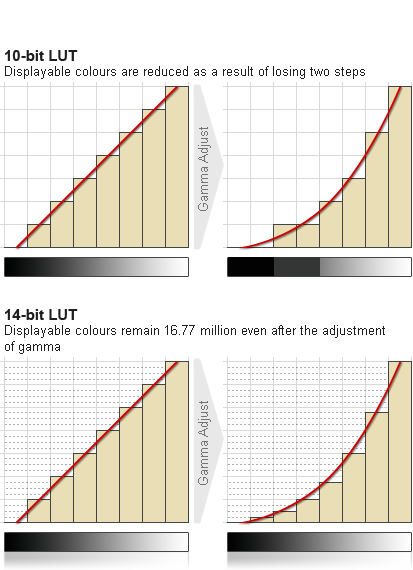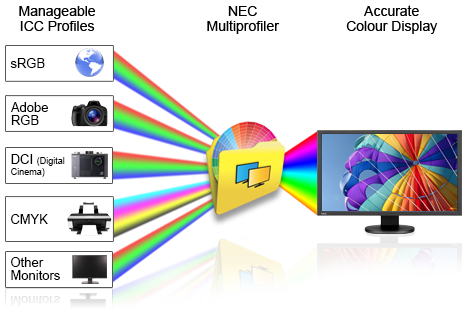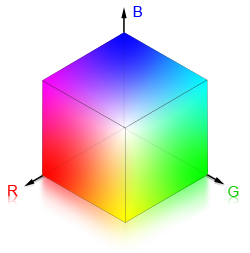Colour Management
Why Calibration?
The aim of colour calibration is to measure and/or adjust the colour response of a device (input or output) to a known state. In International Color Consortium (ICC) terms, this is the basis for an additional colour characterization of the device and later profiling. Colour calibration is a requirement for all devices taking an active part of a colour-managed workflow.
Calibration Methods
- Pure software calibration show loss of tonal values and limited quality
- Combination of software and hardware calibration shows loss of fewest tonal values and semi-professional quality
- Hardware calibration show no loss of tonal values and professional top quality
Step 1 of hardware calibration
Measure luminance and colour of white point and black point using an external sensor and adjustement of the LUT for white point, black point (or Red, Green and Blue point). Tuning of gamma curve (gray shade control).
Step 2 of hardware calibration
Creation of a ICC profile for the operating system (PC/MAC)


ICC Profiles

ICC profile is a set of data that characterizes a colour input or output device, or a colour space, according to standards promulgated by the International Color Consortium (ICC). Profiles describe the color attributes of a particular device or viewing requirement by defining a mapping between the device source or target colour space and a profile connection space (PCS).
More info
Colour Workflow
The 3D LUT Colour Emulation feature of the MultiSync® PA series can take the ICC profile of any device, e.g. printer, and through uploading via the MultiProfiler software application, define the monitor gamut to that specific ICC profile.
Colour Spaces
sRGB (Standard RGB)
- Defined by Microsoft and Hewlett Packard in 1996
- Average CRT monitor space
- Suitable for internet and office applications
- Too small for artwork, not 100 % suited for print workflow
- Contained in Photoshop
- White point D65
- Tonal response curve: modified gamma 2.2
Adobe RGB
- Defined by Adobe in 1998
- Standard working space in the U.S
- Contains 98% of all printable colours
- Contained in Photoshop
- White point D65
- Tonal response curve: gamma 2.2
eciRGB_v2
- Defined by Color Solutions in 2005
- Standard working space in Europe (see www.eci.org)
- ISO standard 22028-2:2007
- Contains 100 % of all printable colors
- NOT contained in Photoshop
- White point D50
- Tonal response curve: L*
dsRGB

Colour space for colour accurate large format display applications. Perfectly matched to NEC large format displays.
- Slightly larger than current sRGB standard
- Red, green, blue primaries (xy coords)
- Tonal response curve (the Gamma curve)
- White point 7500 K
L*a*b* (CIELAB)
The L*a*b* system defines the colour space with a dimension ‘L’ for lightness and ‘a’ and ‘b’ for the colour dimensions based on non-linearly compressed CIE XYZ space coordinates. Changes in colours are similar to human visual perception abilities. It allows precise table profiling and is perfectly suited to exceptionally accurate 14-bit LUT hardware calibration capability of the NEC MultiSync® PA series
Other RGB spaces
- CIE-RGB: mercury spectrum
- PAL, SECAM, NTSC: TV Standards, phosphor
- ProPhoto RGB: digital photography
- Wide Gamut RGB
- DonRGB
- sRGB / dsRGB
- Adobe RGB
- eciRGB_v2
- L*a*b*
3D Look-Up Tables

The integrated 3D LUT with colour emulation preset within the MultiSync® PA series displays, can be used to transform the colour space of the monitor to emulate that of the printer, or other colour workflow device. The 3D LUT is a three dimensional table that maps colours into a different colour space. The Colour Processing Engine allows complex colour gamuts such as those of colour printers to be emulated on the monitor directly. This allows print previews to be performed with applications that do not support this feature directly. The MultiProfiler application can easily load ICC Profiles into the 3D Look Up Tables.
Wide Colour Gamut
Experience the very best in colour image quality with the latest generation of state-of-the-art 10-bit P-IPS technology, with exceptionally wide viewing angle, widest colour gamut available (107% AdobeRGB colour space coverage and 98 % size) and absence of colour shift. The true benefit of a wide colour gamut display is particularly visible when combined with 10-bit panel, since potential colour banding or visible grayscale steps are eliminated.